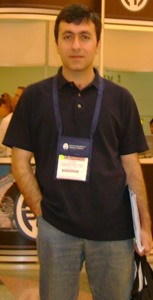Magnetic Particle Spectrometer for Diagnosis of Magnetic Nanoparticles
M Irfan1, N Dogan1, A Bingolbali2*, (1) Gebze Technical University, Gebze/Kocaeli, TR, (2) Yildiz Technical University, Istanbul, TR
Presentations
PO-GePV-M-218 (Sunday, 7/25/2021) [Eastern Time (GMT-4)]
Purpose: Magnetic particle imaging (MPI) is an emerging medical imaging technique that only relies on superparamagnetic iron oxide nanoparticles (SPIONs) as tracer agents. Magnetic particle spectrometer and relaxometer are used as diagnostic tools for evaluation and selection of the best magnetic nanoparticles for MPI usage. In this study, a magnetic particle spectrometer (MPS) is designed at 9.9 kHz to measure the 5th/3rd harmonic ratio, full width at half maximum (FWHM) of the point spread function, and relaxation time of the nanoparticles at 15 mT excitation field.
Methods: Hardware components of the MPS were simulated in COMSOL Multiphysics 5.4. Drive and receive coils were enclosed in cylindrical copper shielding to eliminate the environmental noise disturbance. The direct feedthrough effect of the fundamental harmonics was minimized with the optimized gradiometric design of the receive coil. A highly homogenous excitation field of 15 mT was targeted at the sample position (midpoint of the setup). The setup of the MPS was implemented based on simulated parameters to achieve optimum results.
Results: Commercially available SPIONs (Vivotrax, Perimag) were first tested with home-built MPS. Mn₀.₇₅Fe₂.₂₅O₄ coated with citric acid and Mn₀.₇₅Fe₂.₂₅O₄ coated with polyacrylic acid were characterized at 9.9 kHz with 15 mT (peak amplitude) excitation field, and then compared with the commercial nanoparticles. Mn₀.₇₅Fe₂.₂₅O₄ has a 0.49 (5th/3rd) ratio, 7.60 mT FWHM, and 4.09 µs relaxation time. These results are in good agreement with Perimag. Similarly, Mn₀.₇₅Fe₂.₂₅O₄ has a 0.46 (5th/3rd) ratio, 8.95 mT FWHM, and 4.259 µs relaxation time. The effect of different coatings on the same iron core was analyzed as well.
Conclusion: The home-made MPS provides an opportunity to diagnose magnetic nanoparticles and helps to mark the best tracer agent for MPI scanning. The expected resolution of MPI scanners for specific SPIONs can be estimated from FWHM (mT) of MPS.
Funding Support, Disclosures, and Conflict of Interest: This work was sponsored by the Technological Research Council of Turkey through TUBITAK Grants (115E776 & 115E777). Authors declare no conflict of interest.
ePosters
Keywords
Magnetic Fields, Hyperthermia, Spectrometry
Taxonomy
IM- Other (General): Nanoparticles (general)
Contact Email



